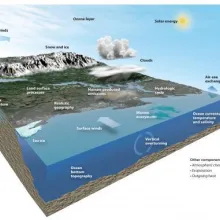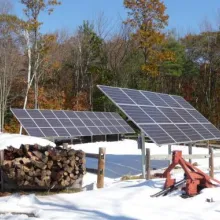
The University of Arizona (UA) and CCASS are particularly well suited to address the following grand challenges:
This is arguably the most challenging aspect of climate adaptation. UA faculty and staff are widely recognized for their exceptional abilities to provide explanations of scientific information that can be used in making specific kinds of decisions and to work in a “co-production” mode with stakeholders, so that scientists are partners in the learning process and stakeholders identify and influence research directions.

Over the last five decades, water from the Colorado River rarely has reached the delta, which used to feed the Sea of Cortez just south of the border between the U.S. and Mexico. Photo: Adrille/Wikimedia Commons.
Enhancing Water Supply Reliability on the Colorado River Project
An ongoing water resources management collaboration of UA and the Bureau of Reclamation, “Enhancing Water Supply Reliability” (EWSR), a project initiated in 2003. With the involvement of public water supply managers and other stakeholders, the project has enhanced understanding of climatological drivers of drought in the Colorado River Basin, evaluated adaptive water management responses to drought and climate change, and developed effective and implementable economic tools for voluntary transfer of water across sectors to improve regional economic adaptation to climate variability. With Reclamation and stakeholders in the Lower Colorado, EWSR developed and evaluated a pilot System Conservation Program now being adapted by other large water management agencies to improve their water supply reliability.
The UA has extensive experience in evaluating social, physical, and ecological climate-related vulnerabilities in an interdisciplinary way, and building training programs in partnership with foundations, the federal government, and the private sector. Working on integrated solutions to complex problems requires special skills in interdisciplinary problem-solving and the ability to incorporate adaptation, mitigation and sustainability objectives into practical solutions.

Naval Base Coronado, site of a pilot study of risk analysis and prioritization strategy being undertaken with SERDP funding. U.S. Navy photo by Mass Communication Specialist Seaman Daniel A. Barker.
Climate Change Impacts and Adaptation on Southwestern DoD Facilities
The U.S. Southwest presents an intensified suite of climate change impacts likely to be experienced by many DoD facilities. In a project funded by the Strategic Environmental Research and Development Program (SERDP), UA researcher Rafe Sagarin is engaging with DoD managers through interviews, workshops and case-study pilots across a range of DoD operations in the Southwest to develop robust approaches to climate change risk assessment, mitigation and adaptation, supported by a set of climate adaptation tools that can be used across DoD operations. The approach combines social and biophysical sciences to determine management needs and then develop tools to help DoD access the most relevant and current climate data available. The process also emphasizes capacity building and network building so DoD personnel can assess new climate threats and make adaptive decisions.
Although the traditional view of adaptation is of gradual and well-managed responses to trends over time, the reality is that extreme events and “step changes”—sudden changes in the climate and environmental conditions—are the real challenges for society. There are limits to engineering solutions to climate adaptation, but experience with recovering from extreme events and non-climate hazards has taught us that different solutions are needed to proactively manage these risks.

The NCAR-based Community Earth System Model (CESM) is one of the world's most sophisticated models of global climate. Created by scientists at NCAR.
EaSM2--Quantifying and Conveying the Risk of Prolonged Drought in Coming Decades (PIs Overpeck, Cole and collaborators Otto Bleisner and Ault)
Drought is expected to become increasingly prevalent in a warming world. In the future, natural hydroclimatic variability will be superimposed on continued human-driven changes to regional climate, with both long-term warming and regional drying likely to exacerbate droughts of the future. Among the greatest challenges of decadal prediction and climate change projection are the quantification of prolonged drought risk in vulnerable regions and the integration of knowledge about this risk into the decision-making processes of the many resource managers and other stakeholders who deal with drought. This project takes advantage of several resources, including simulations from a state-of-the-art Earth System Model (CESM), an expanding set of paleoclimate datasets from multiple proxies, and longstanding collaborations with stakeholders in the SW and Mexico with whom we can develop best practices in applying drought risk estimates to real-world problems.
Conversations about managing risk through adaptation and preparedness often are conducted by researchers and policymakers without serious consideration of the emissions implications of these options, while energy-related decisions often are made by a separate community of people without considering the risks associated with climate change and extreme events. CCASS intends to help bring these communities and conversations together to encourage integration of adaptation and energy solutions.

A range of projects are under development that integrate adaptation options and energy alternatives. Photo by Kathy Jacobs.
Renewable Energy Network
Transformative change in our production and use of energy is one of the most significant challenges of the 21st Century. As energy demands and carbon emissions increase, tremendous pressure is exerted on the reliability and resiliency of existing energy delivery systems and water supplies. The technological, economical, and social factors of energy change, taken together, represent the best opportunity for accelerating progress towards a fundamental shift in our energy future. The UA Renewable Energy Network (REN) is a university-wide initiative directed by CCASS Core Team member Ardeth Barnhart. REN supports the expanded regional, national, and global use of abundant, clean, and economical renewable energy by connecting community and industry to the UA’s research and educational programs.

